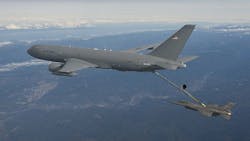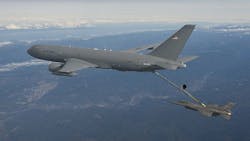Boeing, Air Force log historic KC-46A tanker refueling flight with assist from Rockwell Collins
SEATTLE, 27 Jan. 2016. Boeing and U.S. Air Force aircrews completed the KC-46A tanker’s first refueling flight 24 January 2016 in the skies above Washington state, and the Rockwell Collins Remote Vision System (RVS) played an integral role, officials say.
Following takeoff from Boeing Field in Seattle, the KC-46A flight test team completed a series of checkpoints before offloading 1,600 pounds of fuel to an F-16 fighter aircraft flying at 20,000 feet.
“Today’s refueling flight is an important milestone for the Air Force/Boeing team because it kicks off the Milestone C aerial refueling demonstration, which is the prerequisite for the low-rate initial production decision,” U.S. Air Force KC-46 System Program Manager Col. Christopher Coombs said following the historic event. “We have a lot of work yet to do, but this is an exciting time for the airmen who are preparing to fly, maintain and support the KC-46 Pegasus for decades to come.”
The Rockwell Collins RVS is a combination of 2D and 3D technologies in both visible and long wave infrared spectrums, providing visual information to support refueling operations. The RVS enables the air refueling operator to refuel aircraft at any time, in any weather, and under any lighting conditions, Rockwell Collins officials say.
During the flight, the Air Force’s air refueling operator directed the tanker’s 56-foot boom downward and waited for the F-16 to move into position before fully extending the boom into its refueling receptacle after which the KC-46 then began offloading fuel to the fighter. When the fuel transfer was complete, the system automatically turned off the pumps and the operator retracted the boom.
The KC-46A that accomplished the refueling milestone shortly will begin refueling a number of other military aircraft in addition to the F-16, including a C-17, A-10, F/A-18 and AV-8B. This particular KC-46 (known as EMD-2) made its first flight on 25 September 2015.
The program’s first test aircraft (EMD-1), a 767-2C, has completed more than 260 flight test hours since making its first flight in December 2014. Aircraft EMD-3 and EMD-4 will make their initial flights later this year.
As part of a contract awarded in 2011 to design and develop the U.S. Air Force’s next-generation tanker aircraft, Boeing is building four test aircraft: two are currently configured as 767-2Cs and two KC-46A tankers.
Boeing’s KC-46A is a multirole tanker that can refuel all allied and coalition military aircraft compatible with international aerial refueling procedures, as well as carrying passengers, cargo, and patients. Overall, Boeing plans to build 179 KC-46 aircraft for the U.S. Air Force.
In addition to the RVS, Rockwell Collins provides the following for the KC-46 tanker:
- Integrated display system featuring four 15.1-inch diagonal liquid crystal displays, built on proven technology from the Boeing 787 program, that deliver significantly higher levels of reliability and safety. Each display provides two independently controlled display windows, for a total of eight, that accommodate multiple display functions on a single screen.
- A Tactical Situational Awareness System (TSAS) processor built on a Joint Interoperability Test Command (JITC)-certified system. The TSAS provides situational awareness to the crew, routing cues to avoid imminent threats in the area, and awareness of friendly entities.
- Signal data concentrator network, a DO-178B and DO-254 certified system that forms the avionics network on the aircraft. It uses the ARINC 664 standard for fast translation and sharing of aircraft system information between components.
- State-of-the-art communications, navigation, surveillance, networking, and flight control systems.
Rockwell Collins develops and deploys communication and aviation electronic solutions for commercial and government applications, delivering flight deck avionics, cabin electronics, mission communications, simulation and training, and information management.
Daryl Mayer, 88th Air Base Wing Public Affairs, reports:
"I'm extremely proud of the entire industry and government program team that made today happen,” said Brig. Gen. Duke Z. Richardson, the Air Force program executive officer for tankers, Air Force Life Cycle Management Center. “This aerial refueling marks the first of many, and represents years of hard work beginning to pay dividends.”
You might also like:
Subscribe today to receive all the latest aerospace technology and engineering news, delivered directly to your e-mail inbox twice a week (Tuesdays and Thursdays). Sign upfor your free subscription to the Intelligent Inbox e-newsletter at http://www.intelligent-aerospace.com/subscribe.html.
Connect with Intelligent Aerospace on social media: Twitter (@IntelligentAero), LinkedIn,Google+, and Instagram.

